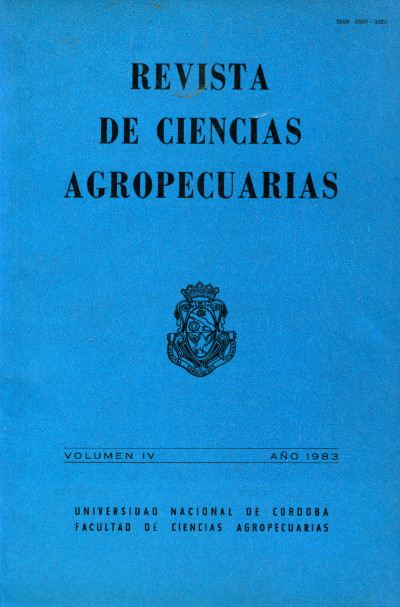Use of prostaglandin F2 alpha as a method to synchronize heat in ovines
Main Article Content
Abstract
Article Details
Issue
Section
How to Cite
References
ADRIAN, E. D. (1950). The electrical activity of the mammaliam olfactory bulb. Electroenceph Clin. Neurophysiology, 2:288-377.
BARIOGLIO, S. E. R. (1981). Liberación de PG inducida por cambios en el potencia] de reposo y hormonas sexuales a partir del miometrio aislado de rata. Tesis de Doctorado. Instituto de Fisiología humana. Facultad de Ciencias Médicas. Universidad Nacional de Córdoba.
BURFENING, P. J. y D. ANDERSON. (1976). Fertility of cows treated with PG F2 alfa and GNRH. Journal of Animal Science, 42:1565.
COOP, I E. (1965). Parición sincronizada en ovinos. Lincoln College. CORFO. Circular N4 11.
DERIVAUX, J. (1961). Fisopatología de la reproducción e inseminación artificial de los animales domésticos. Traducido por José Gómez Piquer. Zaragoza, Acribia, 1961.
EDGAR, D. G. (1963). The influence of rams of the outset of the breeding season in ewes. Proceedings of the New Zeland Society of Animal Productiin, 23:79-87.
GARCIA, G. et al (1970). Efecto de la suplementación invernal y sincronización del estro, sobre la producción de corderos y lana. XXI Jornadas Agronómicas. Chile, 1970.
GARCIA, G. y H. MANTEROLA. (1978). Sistemas de producción de carne ovina en regiones mediterráneas semiáridas. 51 Conferencia Mundial de Prodccción Animal. Buenos Aires, 1978.
PINEDA, M. (1970). Fisiología de la Reproducción de los Animales Domésticos. Valdivia, Universidad Austral de Chile. Facultad de Medicina Veterinaria.
REID, R. N. (1980). PG F2 alfa for oestrus sinchronization or abortion in Polwarth ewes. Aust. Vet. Journal., 56:22-24.
ROBERTS, E. (1966). The estimulation of fertile oestrus Romney ewe I y II. J. of Rep. and Fertility., 12:561-567.
THIMONIER, J. (1981). Practical uses of PG in sheep and goats. Acta Vet. Scand. suppl., 77:193-208.
THOMAS, R. (1968). Synchronization of oestrus. Vet. Rec., 81:240.
TOLEDO Y ZUÑIGA, R. (1969). Influencia de la sincronización del estro y suplementación invernal sobre la producción de cordero y lana. Tesis. Santiago. Chile, 1969.
WHITTEN, W. K. (1971). Pheromones and mammaliam reproduction. National Biological Standarts Laboratory. Camberra, Australia.
WHITTEN, W. K. y F. H. BRONSON. (1979). Estrus inducing pheromone of male mice: Transports by movement of air. Science., Vol. 16.





